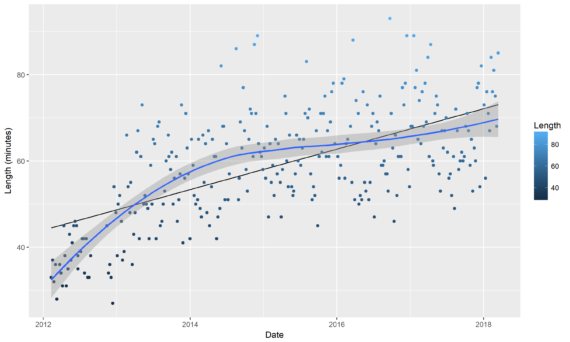Oh, no. Another one of those blog posts about numbers 😜
The Pen Addict Podcast is 299. Episodes old, that is. I happily remember back, listening to the first episode in 2012.
When the first episode came out I put it on a memory card so that could listen to it in my car stereo on a longer drive. I was driving to visit one of my students who was on a placement at the time. On the way there I thought to myself “This is great, but I doubt more than a handful of people would want to listen to this. I can’t see this lasting very long.”. (#myfirsttpa 😋)
Well, how wrong I was! Of course, I am referring to the second part of my sentence.
Back then, before the podcast, to me, Brad Dowdy was ‘the friendly blogger who puts his pictures on Flickr’. Every time I had contact with him he was extremely friendly and not many bloggers had their photos on Flickr. These days I think of him as the most influential stationery blogger who helped to make liking stationery a bit more mainstream. I didn’t know Myke Hurley at all before episode one.
I felt quite honoured when Bleistift was the Pen Blog of the Week in episode 94. Funnily enough, this was because of an ink related blog post, but it still meant that pencils became one of the topics of this episode. The way I know this story (please correct me if you know better) is that a pencil blog being discussed on this episode made Tim Wasem think of starting a pencil podcast and he then talked (or chatted) to Andy Welfle. Together they then approached Johnny Gamber and within a few weeks, the Erasable Podcast was born.
In time for episode 300 I thought I have a closer look at some ‘statistics’. This information is based on the The Pen Addict Podcast page on stationery.wiki, which is basically a query of the semantic data held in the wiki. Please feel free to contribute to the wiki. Everyone’s welcome there.
Let’s have a look at the plot. The x-axis (horizontal axis) is used for the dates of the episodes. The y-axis (vertical axis) is for the episode length in minutes.
Each dot represents an episode. Early episodes are on the left, recent episodes are on the right. Short episodes are on the bottom, long episodes are on the top.

The black line is a straight linear regression line. Looking at this line it seems that every year the episodes get around five minutes longer. If you like long episodes you can look forward to episode 1000. By that time episodes should be more than two hours long 😃.
The blue curve is a LOESS (local regression) curve, which is a bit more ‘flexible’ than the straight line. You can see that in the first two years, until the middle of 2014, episodes gained quite a bit in duration. Growth in duration then slowed down but picked up again since 2017.
Top tip: Why not celebrate the 300th episode when it comes out next week by sharpening a brand new pencil? ..or let others know about your first TPA episode (#myfirsttpa).
If you have just discovered the Pen Addict Podcast recently: there are 295 hours to listen to so far. That’s more than 12 solid days.
As usual, the data and the code used for this plot are available on GitHub.
PS: I know my numbers posts are not very popular, so I’ve been holding off my series of blog post analysing pencil blogs for several years – but be warned, this series will start in the near future
I’d like to thank Alexander Kramer for allowing me to use his Brad and Myke colouring page picture in this blog post.

Nice graphic, I like it and the number posts. (But then again, I also study maths ;D )
Oh. It’s great to hear that maths and stationery seem to go together well 😀. Do you have R classes as part of your degree?
Yes, we used R in one basic statistics course. It’s surely a nice tool for that purpose, but I’m more inclined to traditional informatics and its languages.
Why should maths and stationery conflict?
I use mostly fountain pens and mechanical pencils (0.3,0.4), because writing very small is essential for all those formulas. My most recent fountain pen acquisition is the Pilot CH912 with a PO nib, probably the best nib for writing very small (or on cheap paper).
But inspired by blogs like yours or lexikalikers, I also bought some better pencils (FC 9000 and Staedler Mars Lumograph, easy to get in Germany). They do indeed write very well, I just haven’t found a good use for them.
I had to look that fountain pen up first. I have the Pilot Falcon with an SEF nib. Your and my pen seem to look similar and write similarly fine, but with the PO nib you seem to be able to make sure the writing stays ‘fine’ easier. It seems a great choice.
I think you’ve got it right! Between a pencil blog being on the podcast, and my guest appearance in early 2014, that’s what started the conversation that eventually led to Erasable!
Also, I think your numbers posts are fascinating. Keep up the good work! 😀
Thank you, good to have confirmation that this is how it happened.